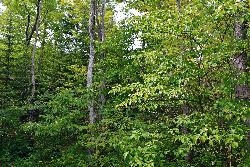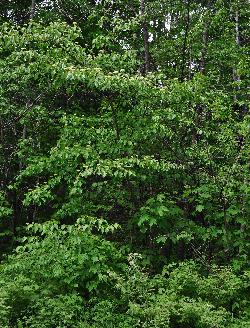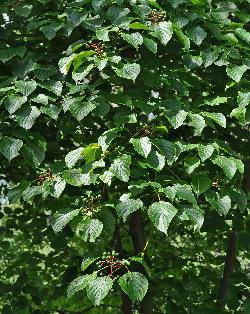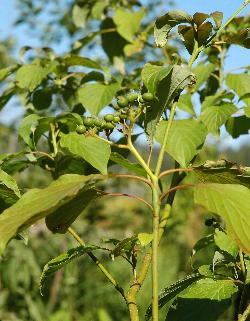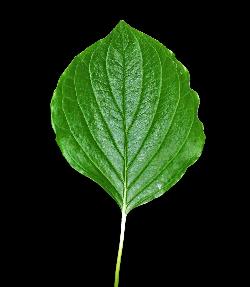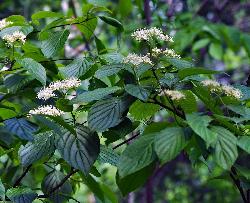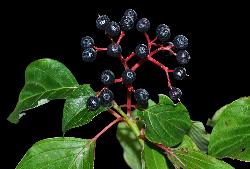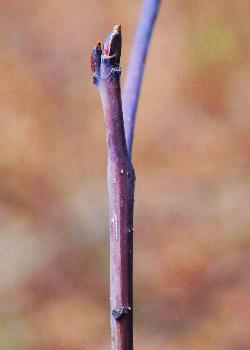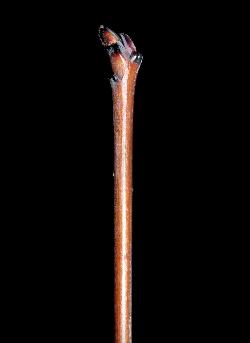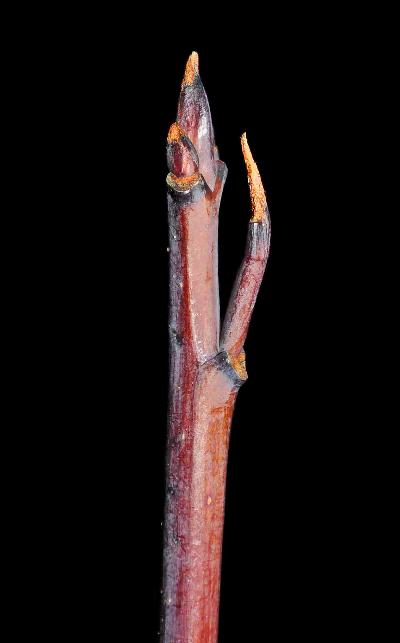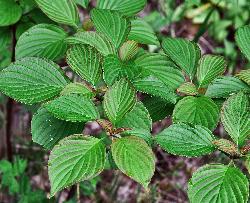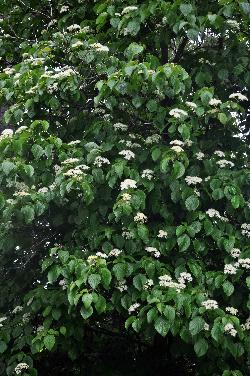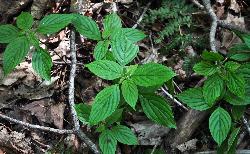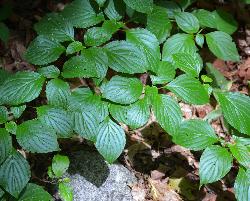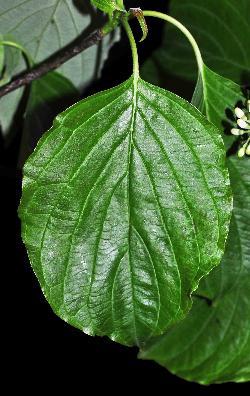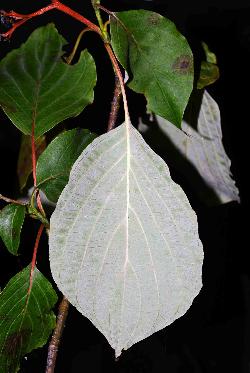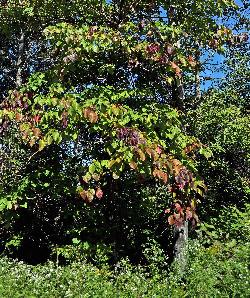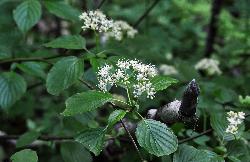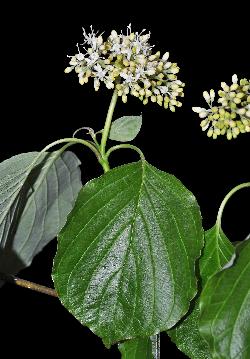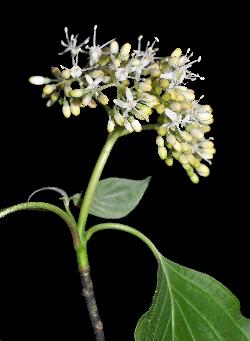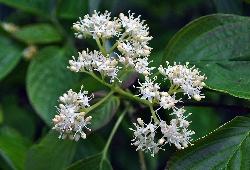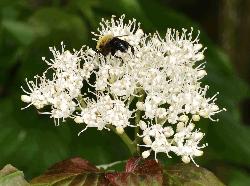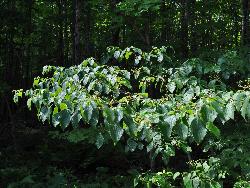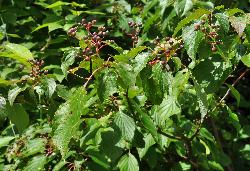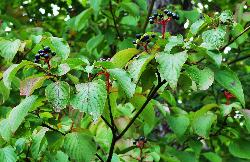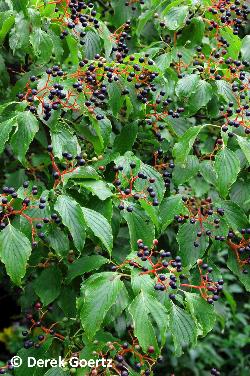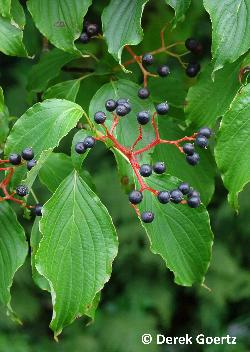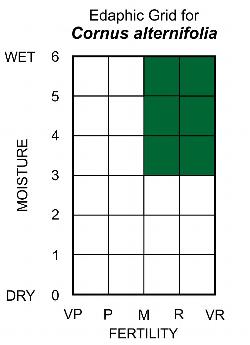Fr: cornouiller à feuilles alternes
Cornaceae - Dogwood Family
Note: Numbers provided in square brackets in the text refer to the image presented above; image numbers are displayed to the lower left of each image.
General: A tall deciduous shrub to small tree, 4–8 m tall [1–3]. Branches are alternate and arranged in horizontal layers with leaves clustered near the upward curving branch tips [4]. Alternateleaf dogwood is a shade-tolerant understorey species that reproduces vegetatively by root sprouts or layering. It provides browse, cover, and/or food for a variety of animals, including bears, beaver, and ruffed grouse (Coladonato 1994).
Key Features:
1. Leaves are alternate, clustered near the branch ends, and droop gracefully on long petioles [4].
2. Leaves are glossy above and pinnately veined with 5–7 pairs of arcuate veins that curve upward towards the apex of the leaf [5].
3. Inflorescences are flat-topped and terminal on upturned branch ends [6].
4. Fruits are dark bluish-black drupes, arranged in branched clusters, and borne on bright red pedicels [7].
Stems/twigs: Twigs are slender, green, greenish-brown, or reddish-purple, glabrous, and often glossy or with a glaucous bloom [8–10]. Buds are alternate and pointed (acute), with 2–3 reddish-purple to blackish imbricate bud scales; leaf scars are narrow and broadly U- to V-shaped, somewhat raised and edged in black, with 3 bundle trace scars. The pith is small and white. Young branches are green [4]; older branches have dark green to light brown bark, while mature trunks have dark grey furrowed bark.
Leaves: Alternate, simple, pinnately-veined, with 5–6 pairs of arcuate veins that curve towards the leaf apex [5, 11]. Petioles are slender, 2–6 cm long, and often tinged with red, along with the midrib of the leaf. Leaves of flowering branches droop gracefully and are crowded at the upturned branch tips [6, 12]. Leaf blades are ovate, elliptic, obovate, or nearly orbicular [5, 13–16], 4–13 cm long by 2–7.5 cm wide, dark green and glabrous above, pale to glaucous, and very finely pubescent beneath [17]. Leaf bases are tapering (cuneate) to rounded; the apex tapers gradually to a point (acute to acuminate); margins are entire, but somewhat wavy when viewed from the side. Young leaves are often suffused with purple or bronze, while in autumn, the leaves turn various shades of orange to deep greenish-purple [18].
Flowers: Bisexual, small, and numerous, arranged in somewhat flat-topped branched inflorescences (compound cymes), 3–6 cm across, on long peduncles [19–20]. Inflorescences branches are finely pubescent. Flowers have a minute 4-toothed calyx, 4 white lanceolate petals, 4 exserted stamens that are longer than and alternate with the petals [21–22], and a single pistil with an inferior ovary. A greenish-white to pale pinkish nectar disk forms a ring around the base of the style. Flowers bloom in early summer. Pollination is by insects (entomophily) [23-24].
Fruit: The young fruit (drupes) are globose and green, with a persistent style at the top that drops off as the drupes mature. The mature drupes are dark bluish-black, fleshy, and borne on bright red pedicels [7, 25–29]. Each fruit is about 6 mm in diameter and contains a single 2-seeded stony pit. Although uncommon, yellow-fruited forms may occur, these are named forma ochrocarpa Rehder, but are not taxonomically distinct. Fruits mature in late summer. Bears and frugivorous birds eat the fruit (endozoochory), which are also dispersed through gravity (barochory).
Ecology and Habitat: Alternateleaf dogwood is a relatively uncommon species in Newfoundland, found only south of Bonne Bay in western Newfoundland. It usually occurs in open, somewhat wet to wet habitats along river banks, alder swamps, and open thickets. It is typically found in deciduous forests farther south in North America, but can persist in western Newfoundland, where the warmest river valleys with the longest vegetation season occur. Other species that display this restricted distribution include: Carolina spring beauty (Claytonia caroliniana Michx.), eastern hayscented fern (Dennstaedtia punctilobula (Michx.) T. Moore), marginal woodfern (Dryopteris marginalis (L.) A.Gray), black ash (Fraxinus nigra Marshall), two-eyed berry (Mitchella repens L.), and feathery false Solomon's seal (Maianthemum racemosum (L.) Link) (Damman 1976).
Edaphic Grid: See image [30]: the Edaphic Grid for Cornus alternifolia.
Forest Types: Because of its relative scarcity, alternateleaf dogwood is not recorded in the Forest Vegetation Classification. Given its preference for nutrient-rich, wet, and open habitats, it could possibly be found in the following forest types:
Aceretum galietosum (Galium-Mountain Maple Thicket Subassociation)
Alnetum solidagetosum (Solidago-Alder-Black Spruce Swamp Subassociation)
Alnetum typicum (Moist-Alder-Black Spruce Swamp Subassociation)
Succession: Alternateleaf dogwood has a wide range of shade tolerance and is found on dry to moist soils under deciduous forests throughout most of its range. In Newfoundland, it is usually found in wet open habitats. It reproduces both by seed and vegetative sprouting. Branches may root and reproduce by layering when in contact with moist soils. On the mainland, it can be a dominant in sugar maple understories but, more often, forms small colonies in open habitats. It can sprout from the root crown and spread by branch layers following cutting. On burns, it appears to recover from seeds dispersed by birds (Coladonato 1994).
Distribution: Alternateleaf dogwood is a relatively uncommon shrub in Newfoundland, restricted to river valleys on the west coast, south of Bonne Bay. In Canada, it has a distinctly southern distribution, extending west from the Atlantic coast around the Great Lakes to Manitoba. In the United States, it occurs southwest from New England to Mississippi, and west through the Midwest States to Minnesota (Coladonato 1994).
Similar Species: All other species of Cornus have opposite leaves and branches. Red-osier dogwood (Cornus sericea L.) has bright red to deep purplish-red stems and white fruit borne on dark purple stalks. Roundleaf dogwood (Cornus rugosa Lam.), an occasional escape from gardens, has broader, nearly orbicular leaves, rough-textured upper leaf surfaces, green to reddish stems mottled with purple, and greenish-white to light blue fruit on pink or pale red pedicels.


